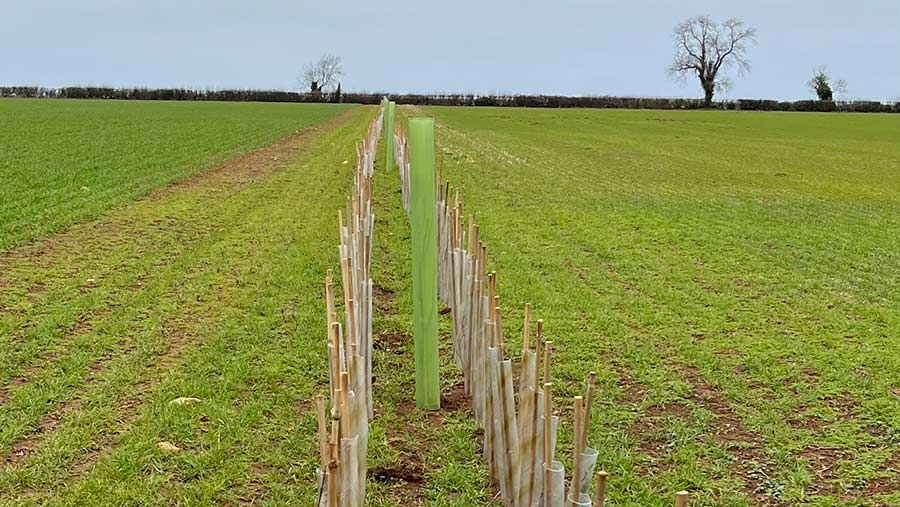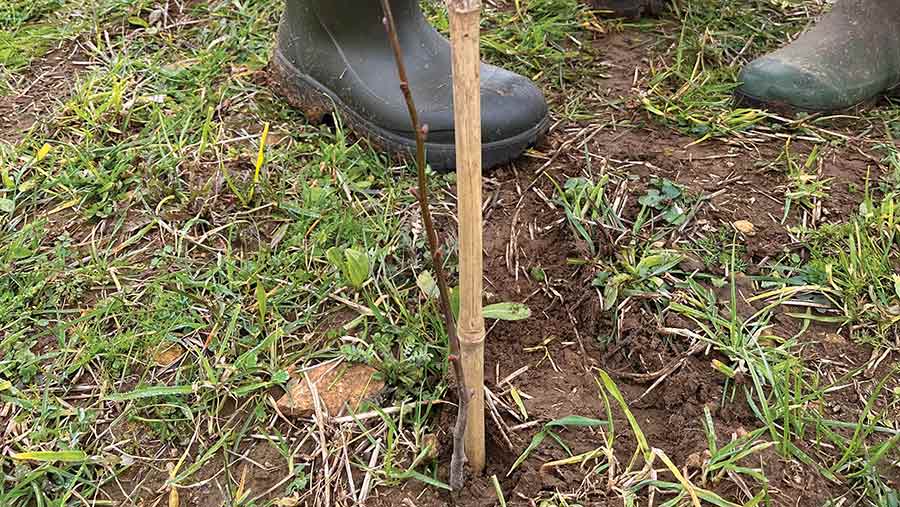Arable farm finds new income streams with nature-based system
 © Dunthrop Farm/Elliot House Communications
© Dunthrop Farm/Elliot House Communications Nature-based solutions are being put to the test on a Cotswolds arable farm, both locally and at scale, to see what benefits and rewards they have to offer.
Dunthrop Farms at Heythrop, near Chipping Norton, has been in a state of change for the past six years, as it makes the farmed environment resilient enough to keep producing food – while also meeting biodiversity and net-zero targets.
See also: Tips on establishing perennial wildflower strips for bees
The farm started by improving soil health and introducing regenerative practices.
It has gone on to plant trees, introduce livestock into the arable rotation, reduce inputs, participate in agri-environment schemes and consider how to stack enterprises, as it generates new income streams and looks for other opportunities.
Group benefits
At the same time, the needs of wider society are also being addressed, through membership of the 130-strong North-East Cotswolds Cluster Group, which collectively covers close to 40,000ha.
Co-operation with others allows the farm to contribute to delivering public goods at scale, explains Dunthrop Farms owner Tim Coates.
This is done through strategic long-term nature recovery actions and sharing of the eventual rewards – which are expected to come from both public funding and private investment.
Taking that collaboration to the next stage, it is also one of 50 farms in an ambitious landscape recovery project – a rivers and streams pilot – which covers the Evenlode catchment.
The group bid successfully for Defra funding and this large-scale project aims to restore the catchment’s natural form.
This will create a contiguous flood plain, providing flood management and biodiversity services over a wide area, as well as improving water quality.
Monetising sustainable activity
Mr Coates, who is also a co-founder of Oxbury Bank, points out that farming’s direction of travel has changed and that a sustainable future depends on the business being involved in local and regional initiatives, so that the outcomes can be monetised.
Emerging natural capital markets and new supply chain initiatives will become increasingly important to farming businesses alongside food production, he believes.
He sees the government’s role as enabling the change that’s required.
“Not doing anything wasn’t an option,” he explains. “If you have good carbon stocks, biologically active soils and a local network of farmers working together, there’s every reason to engage.”
Where natural capital markets are concerned, he is looking at water, carbon and biodiversity.
As a result, two new woodlands have been planted over the past three years, an agroforestry project has been established, and sheep are being used to mob-graze crops and eliminate fungicides and plant growth regulators.
Crucially, he has carried out baselining work, so that he can measure the changes in carbon sequestration, soil organic matter and biodiversity that will occur over time.
That same baseline monitoring has been carried out by Rothamsted Research on 41 of the farms in the North-East Cotswolds Cluster.
This is to help understand how different management practices can make changes occur.
“That will be repeated every five years,” says group facilitator Tim Field. “Armed with the right data, we will be able to trade natural capital at scale through landscape regeneration.”
The cluster also has tree planting targets for the whole catchment, as there is a need for strategically placed blocks of woodland.
By working with the Forestry Commission and Network Rail, agreeing the right projects is more straightforward and private finance can be accessed.
The cluster also handles the application process for grant funding on behalf of members.
This is to ensure that they meet the requirements of various schemes, such as the England Woodland Creation Offer (Ewco), and are Woodland Carbon Code compliant.
The cluster group will benefit from the landscape recovery project too, he notes, as it covers the Windrush catchment, and the results of the measures implemented along the Evenlode are likely to be relevant.
“These large-scale and long-term approaches are essential to meeting biodiversity and climate change challenges,” he says.
What has changed at Dunthrop Farms in six years?

© Dunthrop Farm/Elliot House Communications
Environmental Land Management scheme
Dunthrop Farms is in the Sustainable Farming Incentive pilot and has an existing Mid Tier Countryside Stewardship agreement, now in its third year.
Tim Coates is in the process of making another Mid Tier application, which will complement existing options and build on progress already made.
Woodland
A mixed, native woodland planted three years ago has established well, so a further 5.4ha known as Coronation Copse has just been completed on a new site.
Comprising 10,000 trees, with both broad-leaved and conifer species, the trees have been planted into a herb-rich mix, under the guidance of woodland experts Nicholsons.
Longer term, the plan is to establish some grazing or pasture in front of the copse, so livestock can enter the wood.
Agro-forestry/silvopasture
An agroforestry enterprise was added at the beginning of the year, as Tim Coates believes it offers the potential for 3D farming.
A mixture of fruit and coppice trees was chosen, along with the restoration of parkland trees, and is financed in part by the Natural Environment Investment Readiness Fund.
Sheep
Integrated livestock management means that sheep have become an integral part of the business and are being used instead of fungicides this year to graze cereals and oilseed rape, while also contributing to soil health.
They are also used on the stubble turnips grown ahead of spring peas and on the cover crops.
Sheep services are provided by contractor Karl Franklin (The Pretend Farmer on Instagram), who moves them every one or two days over 1-2ha blocks and also makes use of the farm’s herbal leys with 300 ewes.
Crop inputs
Grazing is being used to remove disease and eventually eliminate the use of agrochemicals on the farm.
Mr Coates is also investigating biological approaches to crop management with interventions based on products such as silica and humic acid.
As the system matures, he hopes fewer interventions will be necessary.
Supply chain integration
An area of the farm has been devoted to producing wildfarmed wheat, which pays a premium for grain produced according to its defined standards.
Other crops, which are grown regeneratively, but don’t currently attract a premium, still offer a big saving in terms of inputs, points out Mr Coates.
“Don’t forget that farming in this way is all about soil health and, either directly or indirectly, soil carbon can be monetised.”
Silvasheep
Dunthrop Farms is also a pilot site for a new business known as Silvasheep, which will see silvopasture used to graze dairy sheep in an integrated production model.
The end product, an added-value natural strained yogurt, will come from a landscape designed to give shade, shelter and diet to the sheep, while also providing ecosystem services and nutritional benefits.
Secondary products include wool, meat, fruit, nuts and timber, with carbon being sequestered and further on-farm habitat provided.
Where is the money coming from?
The key sources of funding/income:
- Sustainable Farming Incentive pilot
- Mid Tier Countryside Stewardship
- Landscape Recovery (currently in pilot stage)
- England Woodland Creation Offer grant (for woodland)
- Natural Environment Investment Readiness Fund (for future re-financing of a natural capital scheme)
- Woodland Carbon Code credits (future income, but ready to sell)
- Biodiversity net gain units (future income, but ready to sell)
- Enterprise stacking (more output from same area of land)
- Premium crops (such as Wildfarmed, etc)

